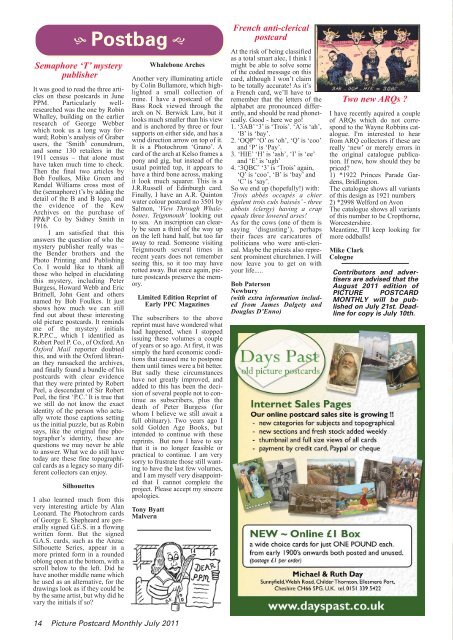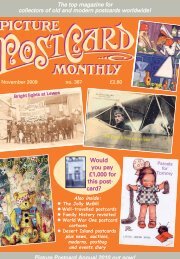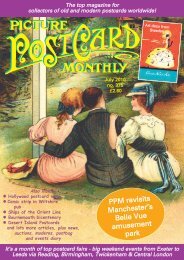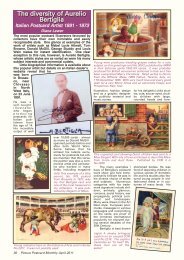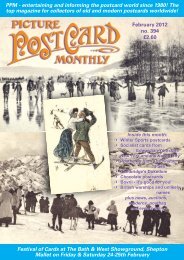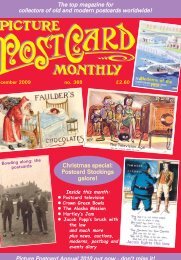You also want an ePaper? Increase the reach of your titles
YUMPU automatically turns print PDFs into web optimized ePapers that Google loves.
� Postbag �<br />
Semaphore ‘T’ mystery<br />
publisher<br />
It was good to read the three articles<br />
on these postcards in June<br />
<strong>PPM</strong>. Particularly wellresearched<br />
was the one by Robin<br />
Whalley, building on the earlier<br />
research of George Webber<br />
which took us a long way forward;<br />
Robin’s analysis of Graber<br />
users, the ‘Smith’ conundrum,<br />
and some 130 retailers in the<br />
19<strong>11</strong> census – that alone must<br />
have taken much time to check.<br />
Then the final two articles by<br />
Bob Foulkes, Mike Green and<br />
Rendel Williams cross most of<br />
the (semaphore) t’s by adding the<br />
detail of the B and B logo, and<br />
the evidence of the Kew<br />
Archives on the purchase of<br />
PP&P Co by Sidney Smith in<br />
1916. I am satisfied that this<br />
answers the question of who the<br />
mystery publisher really was –<br />
the Bender brothers and the<br />
Photo Printing and Publishing<br />
Co. I would like to thank all<br />
those who helped in elucidating<br />
this mystery, including Peter<br />
Burgess, Howard Webb and Eric<br />
Britnell, John Gent and others<br />
named by Bob Foulkes. It just<br />
shows how much we can still<br />
find out about these interesting<br />
old picture postcards. It reminds<br />
me of the mystery initials<br />
R.P.P.C., which I identified as<br />
Robert Peel P. Co., of Oxford. An<br />
Oxford Mail reporter doubted<br />
this, and with the Oxford librarian<br />
they ransacked the archives,<br />
and finally found a bundle of his<br />
postcards with clear evidence<br />
that they were printed by Robert<br />
Peel, a descendant of Sir Robert<br />
Peel, the first ‘P.C.’ It is true that<br />
we still do not know the exact<br />
identity of the person who actually<br />
wrote those captions setting<br />
us the initial puzzle, but as Robin<br />
says, like the original fine photographer’s<br />
identity, these are<br />
questions we may never be able<br />
to answer. What we do still have<br />
today are these fine topographical<br />
cards as a legacy so many different<br />
collectors can enjoy.<br />
Silhouettes<br />
I also learned much from this<br />
very interesting article by Alan<br />
Leonard. The Photochrom cards<br />
of George E. Shepheard are generally<br />
signed G.E.S. in a flowing<br />
written form. But the signed<br />
G.A.S. cards, such as the Anzac<br />
Silhouette Series, appear in a<br />
more printed form in a rounded<br />
oblong open at the bottom, with a<br />
scroll below to the left. Did he<br />
have another middle name which<br />
he used as an alternative, for the<br />
drawings look as if they could be<br />
by the same artist, but why did he<br />
vary the initials if so?<br />
Whalebone Arches<br />
Another very illuminating article<br />
by Colin Bullamore, which highlighted<br />
a small collection of<br />
mine. I have a postcard of the<br />
Bass Rock viewed through the<br />
arch on N. Berwick Law, but it<br />
looks much smaller than his view<br />
and is anchored by three or four<br />
supports on either side, and has a<br />
wind direction arrow on top of it.<br />
It is a Photochrom ‘Grano’. A<br />
card of the arch at Kelso frames a<br />
pony and gig, but instead of the<br />
usual pointed top, it appears to<br />
have a third bone across, making<br />
it look much squarer. This is a<br />
J.R.Russell of Edinburgh card.<br />
Finally, I have an A.R. Quinton<br />
water colour postcard no 3501 by<br />
Salmon, ‘View Through Whalebones,<br />
Teignmouth’ looking out<br />
to sea. An inscription can clearly<br />
be seen a third of the way up<br />
on the left hand half, but too far<br />
away to read. Someone visiting<br />
Teignmouth several times in<br />
recent years does not remember<br />
seeing this, so it too may have<br />
rotted away. But once again, picture<br />
postcards preserve the memory.<br />
Limited Edition Reprint of<br />
Early PPC Magazines<br />
The subscribers to the above<br />
reprint must have wondered what<br />
had happened, when I stopped<br />
issuing these volumes a couple<br />
of years or so ago. At first, it was<br />
simply the hard economic conditions<br />
that caused me to postpone<br />
them until times were a bit better.<br />
But sadly these circumstances<br />
have not greatly improved, and<br />
added to this has been the decision<br />
of several people not to continue<br />
as subscribers, plus the<br />
death of Peter Burgess (for<br />
whom I believe we still await a<br />
full obituary). Two years ago I<br />
sold Golden Age Books, but<br />
intended to continue with these<br />
reprints. But now I have to say<br />
that it is no longer feasible or<br />
practical to continue. I am very<br />
sorry to frustrate those still wanting<br />
to have the last few volumes,<br />
and I am myself very disappointed<br />
that I cannot complete the<br />
project. Please accept my sincere<br />
apologies.<br />
Tony Byatt<br />
Malvern<br />
14 <strong>Picture</strong> <strong>Postcard</strong> <strong>Monthly</strong> <strong>Jul</strong>y 20<strong>11</strong><br />
French anti-clerical<br />
postcard<br />
At the risk of being classified<br />
as a total smart alec, I think I<br />
might be able to solve some<br />
of the coded message on this<br />
card, although I won’t claim<br />
to be totally accurate! As it’s<br />
a French card, we’ll have to<br />
remember that the letters of the<br />
alphabet are pronounced differently,<br />
and should be read phonetically.<br />
Good - here we go!<br />
1. ‘3AB’ ‘3’ is ‘Trois’. ‘A’ is ‘ah’,<br />
‘B’ is ‘bay’.<br />
2. ‘OQP’ ‘O’ os ‘oh’, ‘Q’ is ‘coo’<br />
and ‘P’ is ‘Pay’.<br />
3. ‘HIE’ ‘H’ is ‘ash’, ‘I’ is ‘ee’<br />
and ‘E’ is ‘ugh’<br />
4. ‘3QBC’ ‘3’ is ‘Trois’ again,<br />
‘Q’ is ‘coo’, ‘B’ is ‘bay’ and<br />
‘C’ is ‘say’.<br />
So we end up (hopefully!) with:<br />
‘Trois abbés occupés a chier<br />
égalent trois culs baissés’ - three<br />
abbots (clergy) having a crap<br />
equals three lowered arses!<br />
As for the cows (one of them is<br />
saying ‘disgusting’), perhaps<br />
their faces are caricatures of<br />
politicians who were anti-clerical.<br />
Maybe the priests also represent<br />
prominent churchmen. I will<br />
now leave you to get on with<br />
your life.....<br />
Bob Paterson<br />
Newbury<br />
(with extra information included<br />
from James Dalgety and<br />
Douglas D’Enno)<br />
Two new ARQs ?<br />
I have recently aquired a couple<br />
of ARQs which do not correspond<br />
to the Wayne Robbins catalogue.<br />
I'm interested to hear<br />
from ARQ collectors if these are<br />
really ‘new’ or merely errors in<br />
the original catalogue publication.<br />
If new, how should they be<br />
priced?<br />
1) *1922 Princes Parade Gardens,<br />
Bridlington.<br />
The catalogue shows all variants<br />
of this design as 1921 numbers<br />
2) *2998 Welford on Avon<br />
The catalogue shows all variants<br />
of this number to be Cropthorne,<br />
Worcestershire.<br />
Meantime, I'll keep looking for<br />
more oddballs!<br />
Mike Clark<br />
Cologne<br />
Contributors and advertisers<br />
are advised that the<br />
August 20<strong>11</strong> edition of<br />
PICTURE POSTCARD<br />
MONTHLY will be published<br />
on <strong>Jul</strong>y 21st. Deadline<br />
for copy is <strong>Jul</strong>y 10th.


